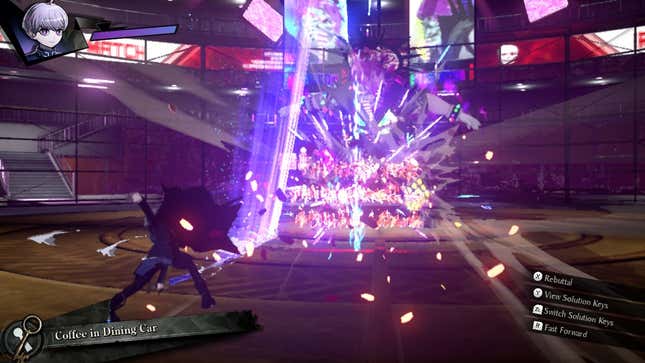I would rather not liken Master Detective Archives: Rain Code to the games its creative team is best known for, but I can’t help it when Spike Chunsoft and Too Kyo Games’ latest murder mystery sure does invite the comparison. Like Danganronpa before it, Rain Code is a murder mystery from the mind of Kazutaka Kodaka, adorned in the distinct art style of Rui Komatsuzaki, all to the backdrop of Masafumi Takada’s techno jazz score. Nearly every mechanic has a near 1:1 equivalent to Danganronpa, to the point where I play through and wonder if everyone involved would rather be making another one of those titles but can’t because of Danganronpa V3’s damning meta-commentary about running a series into the ground until it’s beyond recognition.
Whatever the motivation, Rain Code still has a lot of Danganronpa’s pink blood running through its veins, and while it takes some time to start living up to its predecessor, it had me wrapped around its finger by its final cases and hopeful that Kodaka may have found a new outlet to indulge his fascination with mysteries without returning to a story that’s long finished.

Rain Code follows a detective-in-training Yuma Kokohead in a world where detectives are superpowered figures respected around the world. He’s an amnesiac who’s made a deal with a death god named Shinigami who takes the form of a purple puffball ghost with a love of carnage and death, all while basking in it with lighthearted whimsy. Much like Kodaka’s previous work, the game uses the two characters’ contrasting views of the world to constantly oscillate between dire stakes and absurdist humor but uses its supernatural framing to crank the team’s usual antics up to an inevitable over-the-top conclusion. Much of Rain Code feels like Kodaka’s writing style at his most unhinged, no longer bound by the limitations of a (relatively) grounded setting and free to use magic, superpowers, and god-like entities to justify some wild imagery, for better or worse.
For the first few chapters, I was put off by Rain Code’s supernatural elements and how they framed the mystery-solving. As Yuma and Shinigami stumble into solving crimes around the city of Kanai Ward, Shinigami opens up a pocket dimension to a Mystery Labyrinth. These are pretty comparable to a Palace in Persona 5 in that they are physical manifestations of the mystery itself. Every question there is about a case is given a literal form, whether that be doors to walk through to answer a multiple-choice question or an enemy that Yuma must fight with a truth-bearing blade to literally cut through their arguments as they appear in text on the screen.
Danganronpa represented these same concepts through mini-games that were more symbolic, such as imagining yourself snowboarding down a slope and choosing paths representing answers as you made deductions. Rain Code uses the Mystery Labyrinth to give everything a diegetic place in its world. I admire the commitment to the bit, but the framing initially felt like it was the game bending over backward to bring Danganronpa mechanics into a legally distinct format in a way that justified every moment of deduction and reasoning in a tangible way, rather than a conceptual one.
It wasn’t until later chapters where Rain Code started to really reckon with the reality of using the Mystery Labyrinth that I started to buy in. Shinigami is a ghost when she and Yuma are in the real world, but once they enter the Labyrinth, she sheds her mascot character design for her true form: which is a tall, gothic woman who reaps upon the souls of the culprit at the end of each case. Once Yuma is confronted with the truth, he is also confronted with the cost of finding it. Unlike Danganronpa, this method and outcome aren’t forced on Yuma, he just continually falls on it as he’s put on his back foot. At its core, Rain Code is about the pursuit of the truth and its consequences, but while Shinigami leaves bodies in her wake, the game posits that the truth isn’t meant to be morally right or wrong. In exposing it, people can build from the truth rather than tear themselves down further.
This is why Rain Code constantly invites comparisons to Kodaka’s most prolific work. If it weren’t for all the clear mechanical and artistic parallels, that baseline belief in people is the symmetry that connects this team’s past and present work. Rain Code’s latter chapters invoke the same outburst of emotions that this team is best known for, even if it takes its time getting there. In many ways, its narrative and mysteries get messy, sometimes diluted by the supernatural framing rather than enhanced by it. But despite my initial misgivings, I was surprised at how well it came together. Given this team’s history, I probably should’ve trusted Rain Code to get me by the end.
All the framing aside, Rain Code does feel rough around the edges from a technical standpoint. Rather than using the 2D sprite-based visual novel style of Danganronpa, pretty much everything in Rain Code is rendered in 3D, and this game chugs something fierce on Switch. Whether it’s during the exploration segments through Kanai Ward or the action-oriented setpieces within the Mystery Labyrinth, the game often feels like it’s struggling to hold itself together. While third-person, 3D setup gives Rain Code its own flavor and allows the game some pretty spectacular visual moments (the neon-soaked cyberpunk aesthetic of Kanai Ward looks great when it’s not in motion), there were stretches of time where it felt like the game needed another pass for technical polish.

At a certain point, I think I became desensitized to the framerate drops and bought into the concept and was happy to dive into Mystery Labyrinth. Comparatively, Rain Code’s cases aren’t quite as elaborate as its predecessor’s, but they each had satisfying mysteries and an explosive human element at their core. Even when I would feel skeptical about a reveal, Rain Code would quickly point to a clue I’d long forgotten that tied things together. Some solutions might have felt farfetched, but within the world it established, these cases felt airtight and satisfying to solve, even when the conclusion was devastating to watch unfold.
Rain Code is built by a team that knows how to make these kinds of games, and as a long-time fan of the themes Kodaka tends to write around, I was pretty moved by the end even though it nearly lost me in the beginning. If you’ve never been a fan of Kodaka’s mix of camp, heavyhanded themes, and theatrics, Rain Code will likely not grab you. But despite it feeling like Danganronpa’s distant cousin, it makes it clear this team doesn’t have to lean on Monokuma’s death game as a crutch and can build something new upon its bones instead. Hopefully, this means Kodaka can continue to let old things die on their own terms and make new things instead.























